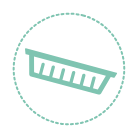The COMMITMENT between Food Conservation & Recyclability:
A monolayer solution is ALWAYS preferred IF it ensures the properly food conservation for shelf-life requirements AND the monolayer solution complies with the Design for Recycling Guidelines.
Use a multilayer solution ONLY IF it is technically needed, because the alternative monolayer solution does not ensure the properly food conservation for shelf-life requirements, AND the multilayer solution complies with the Design for Recycling Guidelines.
GUIDELINES TO ENSURE THE RECYCLABILITY OF THERMOFORMED PET CONTAINERS
Multilayer structure in high barrier solutions
Know the advantages of PET thermoforms

IT IS RECYCLABLE PACKAGING
Las capas que componen el envase se separan y se reciclan los polímeros para su posterior incorporación en nuevos envases termoformados de PET. Desde 2009, se han reciclado más de 65.000 toneladas.

IT EXTENDS THE SHELF LIFE OF FOOD
Thanks to the properties provided by the different layers, which act as a barrier for certain gases, foods are better preserved and their shelf life is extended.

IT CONTRIBUTES TO REDUCING CO2 EMISSIONS
The lightness of the packaging allows for a reduction in fuel consumption in transporting foodstuffs and optimizes distribution.

ECODESIGN
Dos criterios sencillos en el diseño de envases termoformados de PET para garantizar su RECICLABILIDAD son EVITAR EL COLOR y los ADHESIVOS NO RECICLABLES (por ejemplo el poliuretano)
PET THERMOFORMED PACKAGING
PET Thermoform is a recyclable container that allows the incorporation of recycled material in its manufacture. To this great environmental advantage are added additional ones derived from its functional properties during its use stage (lightness and conservation). The composition of the PET tray varies depending on the packaged food in order to give it the most suitable properties for its transport and conservation, but in all cases and regardless of the number of layers it has, the content by weight of PET ranges from 90% and 100%.
LIGHTNESS
PET is a very light material that allows a large amount of product to be packaged using a small amount of material. This property allows the environmental impact of transporting packaged foods to be minimised. With just 15 gr of PET it is possible to package 18 times the weight of a fresh food. This has been achieved thanks to technological evolution in the engineering processes for manufacturing the sheet from which the container is subsequently manufactured by thermoforming.

PRESERVATION
PET thermoforming allows food to be packaged safely and with protection. Its high barrier properties and its resistance to abrasion and attacks by microorganisms allow packaged foods to be safely preserved so that they keep their nutritional properties intact. With a thermoformed PET container it is possible to extend the average conservation time of a fresh food between 50 (cooked foods) and 90 days (dry foods) more than if the same food were purchased in bulk and without this type of container for its conservation.

Far from consuming high amounts of resources, PET is a material characterized by having achieved an excellent environmental balance in its different packaging applications, from its manufacturing phase, in which the technology has been optimized to minimize energy consumption, to its end-of-life phase, given its 100% recyclability.
Food safety is another key element that makes PET thermoforming the ideal container thanks to the high technological level achieved by companies in the manufacturing and recycling processes of PET in compliance with the extensive European legal framework in this area.
RECYCLING PROCESS


Grinding of the material to obtain flakes.
Physical delamination process


Separation of PET and polyolefins.
Removal of impurities (PET colour flakes) using an optical separator.


Quality control of all batches.
End products, high-purity PET flake (90%) and PE pellets (10%).

MAIN IMPEDIMENTS TO RECYCLABILITY

Using Polyurethane (PU) adhesive between the layers makes it impossible to recycle the container.
The presence of polymers with a density similar to that of PET (such as PVC and PS), forming part of the container itself or of the PET thermoformed container bale, makes recycling very difficult because their separation is very complex.
Using colored material both in the base of the thermoformed container and in the lid drastically reduces the use of the bale and, while not making it impossible to recycle, greatly limits the release of the recycled product and its final applications onto the market.






